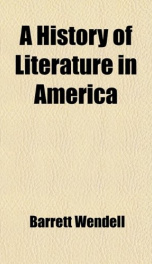a history of literature in america

Purchase of this book includes free trial access to www.million-books.com where you can read more than a million books for free. This is an OCR edition with typos. Excerpt from book: II ENGLISH LITERATURE FROM 1600 TO 1700 References For this chapter, as for the others on English literary history, the general authorities (see p. 31) are sufficient. Whoever wishes more about this period may consult George Saintsbury's History oj Elizabethan Literature, London: Macmillan, 1887, and A. W. Ward's History oj English Dramatic Literature to the Death oj Queen Anne, 3 vols., London: Mac- millan, 1809. The Three The social history of seventeenth-century England Periods. groups itsclf in three parts: that which preceded the dominant Puritanism of the Commonwealth; the dominant Puritanism itself; and what came after. All three of these phases of English life found expression in literature. Between 1600 and 1605 appeared plays byDekker, Ben Jon- son, John Lyly, Shakspere, Marston, Middleton, Hey- wood, and Chapman; Florio's translation of Montaigne; Campion's Art oj English Poetry; and, among many other lesser works, the last volume of Hakluyt's Voyages. Between 1648 and 1652 appeared works by Fuller, Herrick, Lovelace, Milton, Jeremy Taylor, Baxter, Bunyan, Izaak Walton, and George Herbert. Finally, between 1695 and 1700 appeared plays by Congreve, Farquhar, and Vanbrugh; and works of one sort or another by Bentley, Defoe, Evelyn, Lord Shaftesbury, and Dryden; not to speak of Tate and Brady's version of the Psalms. These random lists will suggest the outline of the literary history we need to keep in mind. The beginning of the century marked the height of Elizabethan literature, in which the central figure is Shak- spere. Among the men who were writing in the middle of the century, men in whom the Elizabethan spirit was no longer strong, one rose almost as superior to the rest as Shakspere had been fifty years before. That one, of course, is Milton (1608-1...
Info about the book
Author:
Series:
Unknown
ISBN:
1271417502
Rating:
4/5 (4)Your rating:
0/5
Languge:
English
Users who have this book
Users who want this book
What readers are saying
What do you think? Write your own comment on this book!
write a commentGenre
if you like a history of literature in america try:
Other books by this author
Do you want to read a book that interests you? It’s EASY!
Create an account and send a request for reading to other users on the Webpage of the book!


